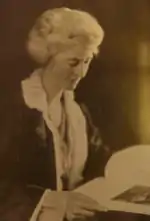Anne Douglas Sedgwick
Anne Douglas Sedgwick (28 March 1873 – 19 July 1935) was an American-born British writer. The daughter of George Stanley Sedgwick, a businessman and Mary (Douglas) Sedgwick, she was born in Englewood, New Jersey but at age nine her family moved to London. Although she made return visits to the United States, she lived in England for the remainder of her life.
Anne Douglas Sedgwick | |
|---|---|
 Anne Douglas Sedgwick circa 1921 | |
| Born | 28 March 1873 Englewood, New Jersey, United States |
| Died | 19 July 1935 (aged 62) Hampstead, England |
| Occupation | Novelist |
In 1908, she married the British essayist and journalist, Basil de Sélincourt. During World War I she and her husband were volunteer workers in hospitals and orphanages in France.
Her novels explored the contrast in values between Americans and Europeans. Her best-selling novel Tante was made into a 1919 film, The Impossible Woman, and The Little French Girl into a 1925 film of the same name. In 1931, she was elected to the United States National Institute of Arts and Letters. Four of her books were on the list of bestselling novels in the United States for 1912, 1924, 1927, and 1929 as determined by The New York Times.
Sedgwick died in Hampstead, England in 1935.[1] The following year her husband published Anne Douglas Sedgwick: A Portrait in Letters.[2]
Bibliography
.png.webp)
- The Dull Miss Archinard (1898)
- The Confounding of Camelia (1899)
- The Rescue (1902)
- Paths of Judgement (1904)
- The Shadow of Life (1906)
- A Fountain Sealed (1907)[3]
- Valerie Upton (1908)
- Amabel Channice (1908)
- Franklin Winslow Kane (1910)
- Tante (1912) – No.9 for the year in the U.S.
- The Nest (collection of short stories) (1913)[4]
- The Encounter (1914)
- A Childhood in Brittany Eighty Years Ago (nonfiction) (1919)
- The Third Window (1920)
- Christmas Roses and Other Stories (1920)
- Adrienne Toner (1922)
- The Little French Girl (1924) – No.3 for the year in the U.S.[5]
- The Old Countess (1927) – No.9 for the year in the U.S.[6]
- Dark Hester (1929) – No.3 for the year in the U.S.
- Philippa (1929)
References
- "Anne D. Sedgwick, Novelist, Is Dead". The New York Times. 22 July 1935.
- Woods, Katherine (25 October 1936). "Anne Douglas Sedgwick as Her Letters Reveal Her (book review)". The New York Times.
- "Beauty and Power in a New Novel (book review)" (PDF). The New York Times. 2 November 1907.
- "Miss Sedgwick's Stories (book review)" (PDF). The New York Times. 30 March 1913.
- (12 September 1924). The Little French Girl – A New Novel by Anne Douglas Sedgwick, Milwaukee Journal
- (2 April 1927). 'The Little French Girl Theme' Revised in 'The Old Countess', Milwaukee Journal
External links
| Library resources about Anne Douglas Sedgwick |
| By Anne Douglas Sedgwick |
|---|
 Works by or about Anne Douglas Sedgwick at Wikisource
Works by or about Anne Douglas Sedgwick at Wikisource- Works by Anne Douglas Sedgwick at Project Gutenberg
- Works by Anne Douglas Sedgwick at Faded Page (Canada)
- Works by or about Anne Douglas Sedgwick at Internet Archive
- Works by Anne Douglas Sedgwick at LibriVox (public domain audiobooks)

- Anne Douglas Sedgwick at IMDb